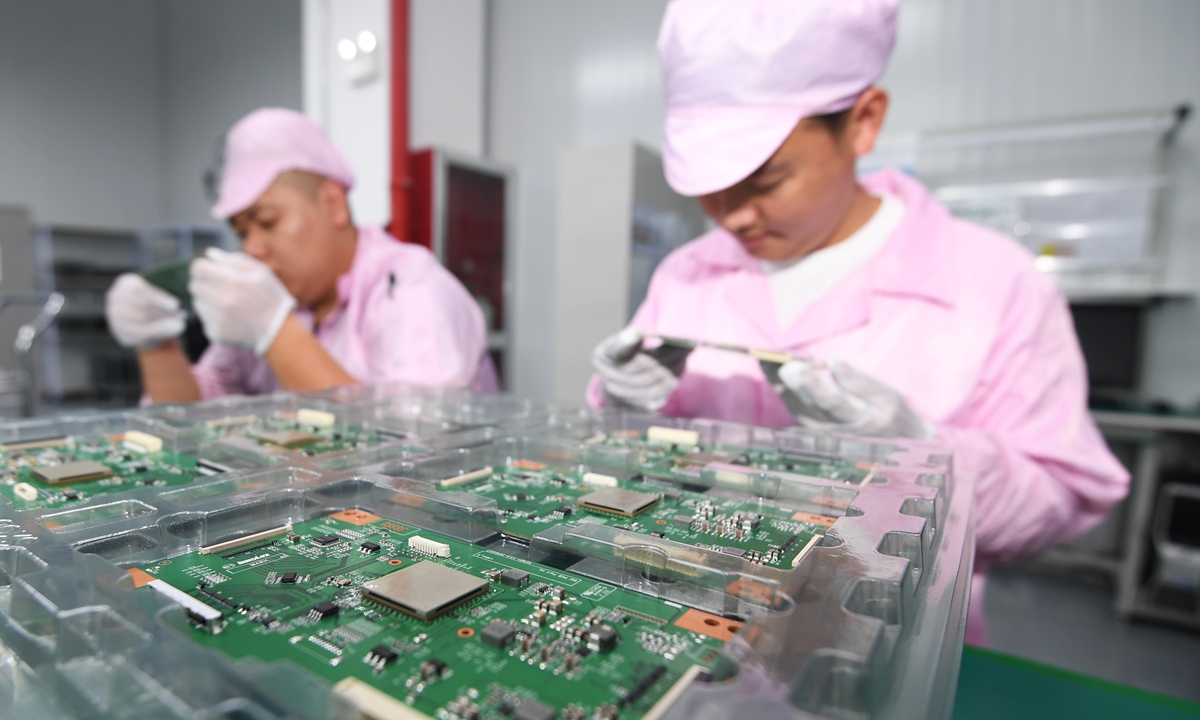
Workers make semiconductors at a company in Guiyang, Southwest China's Guizhou Province. Photo: cnsphoto
As the US continues to build ever higher technological barriers in the semiconductor industry, China needs to embrace a growing sense of urgency when it comes to taking an initiative in boosting multilateral cooperation in the Asian chip industrial chain.
It needs to make full use of the advantages brought by the Regional Comprehensive Economic Partnership (RCEP) in terms of reduced tariffs in relevant fields such as semiconductors and displays as well as the continuous opening-up of the manufacturing sector to speed up mutual investment in the regional semiconductor industry.
US-based memory chipmaker Micron Technology will shut down its DRAM design operations in Shanghai by the end of this year, and some of the 150 Chinese engineers at the site will be granted immigration packages to the US or India, the South China Morning Post reported on Wednesday.
Such immigration arrangement for the technology team is unusual, which, to a certain extent, offers a peek into the intensity of the competition between China and the US for technology talent in the semiconductor sector.
The news came just a few days after US chip giant Intel announced a $20 billion investment in a new semiconductor plant in the US state of Ohio, which the company expects to become the world's largest semiconductor manufacturing site. The plan was seen by some US politicians like Ohio Governor Mike DeWine as highly encouraging, as it represents "a signal to China and to the rest of the world that from now on, our essential manufactured products in this country will be made in the United States of America."
Both the US chip giants' tightened controls over the chip manufacturing and design as well as US politicians' attitude toward protecting their chip industry highlighted the growing challenges faced by China's semiconductor industry development. Now the US is piling up pressure on global semiconductor companies to set up facilities on its home turf, while trying its best to blocking China's access to high-end chip-manufacturing technology.
To beat China's technological ambitions and maintain US leadership in the semiconductor sector, the US government also rolled out various measures to restrict Chinese companies from using US high-end technology and products in a bid to squeeze China out of the semiconductor supply chain.
It is impossible for China to play technological catch-up in the semiconductor sector by acquiring semiconductor firms - as reflected by the terminated deal of acquiring Magnachip Semiconductor, therefore, China needs to develop its own chip industry with the help of regional partners.
At present, the global chip industry is still concentrated in Asia, which is also the largest market for chip application. But with the US determined to tighten control on the semiconductor supply chains, the whole region is now facing serious challenges of being deprived of the competitive edge.
While the US has been at the upper stream of key technologies within the semiconductor industry, China is the largest chip market globally and its market space will allow it the room to develop the chip technologies and pursue regional cooperation despite Washington's hegemonic obstruction.
Under the framework of the RCEP, China could make use of its existing advantages to open its domestic market more to foreign semiconductor companies and to allow them to participate in the construction of China's industry chain, promoting the technological development of local players.
Moreover, the RCEP is also conducive to improving the industrial connectivity between countries and regions to facilitate the formation of semiconductor business cluster in the Asian region, which may help prop up advanced semiconductor technology innovation with improved efficiency.




